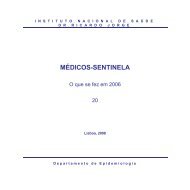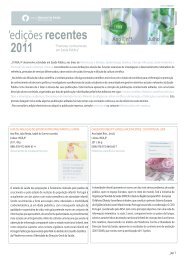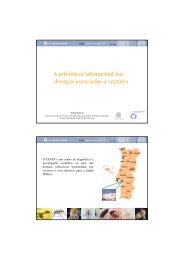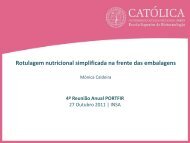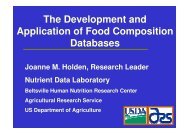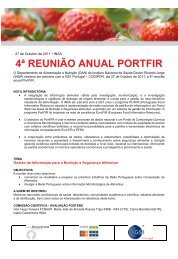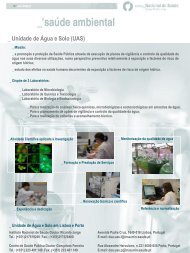European Society of Mycobacteriology - Instituto Nacional de Saúde ...
European Society of Mycobacteriology - Instituto Nacional de Saúde ...
European Society of Mycobacteriology - Instituto Nacional de Saúde ...
You also want an ePaper? Increase the reach of your titles
YUMPU automatically turns print PDFs into web optimized ePapers that Google loves.
PP-21<br />
MOLECULAR STUDY OF RECURRENT TUBERCULOSIS CASES<br />
Alves, Adriana; Miranda, Anabela; Tuberculosis Reference Laboratory Group<br />
Tuberculosis Reference Laboratory, Department <strong>of</strong> Infectious Diseases, National Institute <strong>of</strong> Health, Porto, Portugal<br />
Tuberculosis recurrence is frequently attributed to reactivation <strong>of</strong> the isolate responsible for the first episo<strong>de</strong> <strong>of</strong> the<br />
disease. Nevertheless, this can also be due to an infection with another isolate, or to mixed infections. Clarification <strong>of</strong><br />
the cause <strong>of</strong> recurrence is very important and can be achieved by molecular typing <strong>of</strong> serial isolates <strong>of</strong> M. tuberculosis. The<br />
most appropriate methods to do so are IS6110 RFLP and MIRU-VNTR.<br />
In this work, 39 clinical isolates <strong>of</strong> M. tuberculosis belonging to nine individuals with recurrent disease were studied<br />
throughout time. Seven <strong>of</strong> these patients were resistant to isoniazid and rifampicin as well as to most other 1 st and 2 nd<br />
line drugs. Another patient was resistant to isoniazid and streptomycin, and the last one was resistant to rifampicin only.<br />
For some <strong>of</strong> these individuals, resistance to drugs worsened during the cause <strong>of</strong> the disease, which in some cases has<br />
lasted for more than a <strong>de</strong>ca<strong>de</strong>. All 39 strains were analyzed by IS6110 RFLP. MIRU-VNTR was used to type: (i) the first<br />
strain <strong>of</strong> each patient when serial isolates showed no change in the IS6110 RFLP pr<strong>of</strong>ile; or (ii) each strain with a pattern<br />
change in relation to the previous one.<br />
RFLP results showed that only one out <strong>of</strong> nine patients displayed a change in the pattern <strong>of</strong> serial isolates with gain <strong>of</strong><br />
one IS6110 element. Analysis <strong>of</strong> the results using Bionumerics grouped these patients in nine clusters, being that: (i) strains<br />
from two patients belong to the same cluster; and (ii) strains <strong>of</strong> one patient are divi<strong>de</strong>d in two clusters. Results <strong>of</strong> 15<br />
MIRU-VNTR loci typing corroborate the IS6110 RFLP findings. In other words, the serial isolate that gained one IS6110<br />
element also shows a change in MIRU-VNTR results. In this case, we observed a reduction <strong>of</strong> one repeat in loci Mtub21<br />
and QUB11b. Finally, 40% <strong>of</strong> these strains belong to the LAM family, 10% to the Haarlem family, and the remaining 50%<br />
did not find a match in the database.<br />
This work shows that the cause <strong>of</strong> recurrent tuberculosis <strong>of</strong> the nine patients inclu<strong>de</strong>d in this study is due to persistence<br />
<strong>of</strong> initial M. tuberculosis strain or to reactivation when there is more than one episo<strong>de</strong> <strong>of</strong> disease. Antibiotic resistance is<br />
the most important cause <strong>of</strong> chronic tuberculosis in these patients, since all analyzed strains are resistant to the majority<br />
<strong>of</strong> the 1 st and 2 nd line drugs.<br />
<strong>European</strong> <strong>Society</strong> <strong>of</strong> <strong>Mycobacteriology</strong> | 30 th Annual Congress | July 2009 | Porto - Portugal<br />
93



